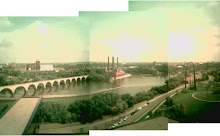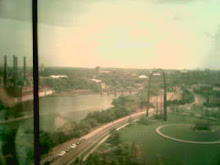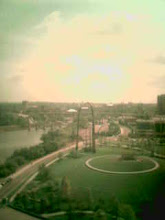Wednesday, August 8, 2007
Bridge Watching
How about a public project that lists bridges of interest; those who have a combined low ratings for safety and are highly trafficed. Armed with this list folks can assign themselves to the bridge and go take as many photos, videos and notes on structural details as possible. If we are lucky, some structural engineers who are game can join with teams of bridge analyzers.
Postings of the photos, videos, notes and commentary on each bridge can be used to influence attention on bridges that appear to be in dire need of repair or replacement.
Postings of the photos, videos, notes and commentary on each bridge can be used to influence attention on bridges that appear to be in dire need of repair or replacement.
Tuesday, August 7, 2007
Fact sheet on the I35 Bridge from Minnesota Department of Transportation
- Built in 1964
- Opened to traffic in 1967
- Original cost for the bridge was $440,740 to construct the piers and $4,828,262 to construct the bridge
- Carried about 140,000 vehicles daily, including 4,760 commercial vehicles
- Scheduled for reconstruction in 2020-25
- Deck steel truss was made up of three parts: the deck, superstructure and substructure
1,907 feet long, 14 spans - Had been inspected annually since 1993; before that, was inspected every two years
Monday, August 6, 2007
35W bridge over the Minnesota river is the same build type as the one that collapsed?
I have been looking up research on the collapsed bridge.
The 35W bridge over the Mississippi is designated as bridge 9340.
Unless I am mis-reading the information, the 35W bridge over the Minnesota river is one of the fracture critical bridges built in the same manner as the 35W bridge over the Mississippi that collapsed. Please inform me if I am.
Look at the paraphrased quote [#1] below.
then read the paragraph it came from [#2],
THEN read the whole article [#3.]
Where is the immediate inspection of the 35W Minnesota River bridge?
It is the same type of bridge, unless I am misreading the text.
Where is the action promised and public notice daily of the inspection statuson each questionable bridge?
My family went over the Minnesota river bridge on 35W bridge yesterday.I saw no inspection. There should be the actual thorough inspection PLUS the spectacle of a state and country making sure everyone knows that they are putting words into action.
There is no information broadcast that 35W over the Minnesota river bridge is of the same type that collapsed.
Let's NOT spend our money first on rebuilding a bridge that should have been shut down years ago, lets spend money shutting down any other faultily designed bridges first, inspect them and rebuild if necessary.
Next read the focus report on bridge 9340[ # 4], the one that collapsed.It seems schizophrenic; the bridge is prone to catastrophic failure if one of the main membersfails, but the Executive summary states that rebuilding can be deferred.
~~~~~~~~~~~~~~~~~~~~~~~~~~~~~~~~~~~~~~~~~~~~~~~~~~~~~
#1 "One of the steel continuous beam span bridges [with fracture critical (FC) elements] was 35W over the Minnesota River"
#2Effects of Increasing Truck Weight onSteel and Prestressed Bridges
2003-16 Final Report
3.1.4 Fracture Critical
A fracture critical bridge is a bridge that contains at least one memberor connection that would cause collapse of the structure if that element failed. There were six bridges along Interstate35that had fracture critical (FC) elements, as well as the Blatnik Bridgein Duluth on I-535. Fourofthe bridges on Interstate 35 were in the Twin Cities Metro Area and theother two are in theDuluth Area. Three of these bridges were steel continuous beam spans,two were steel continuous deck girders, and one was a steel continuous deck truss. Oneof the steel continuous beam span bridges was 35W over the Minnesota River, and the FC elements were pins in a link joint detail. For the other two steel continuous beam span bridges, the FC elements were steelpier caps. One of these bridges was 35W over T.H. 280, and the other onewas in Duluth. One of the steel continuous deck girder bridges was located in Duluth andthe FC element was pier caps. The other steel continuous deck girder bridge was the 35E bridge over the MississippiRiver and the FC elements were pins and it was also a two-girder bridgewith continuous span46 welds. The truss bridge was the 35W bridge over the Mississippi River(#9340); and the FC elements were truss tension members. The tension chord on the truss of the Blatnik Bridge is also fracture critical. The Blatnik Bridge also has a link joint detail with pins. If one of the pins or the link plate fractures, the bridge could collapse.
#3 http://www.cts.umn.edu/Research/ProjectDetail.html?id=2000003
~~~~~~~~~~~~~~~~~~~~~~~~~~~~~~~~~~~~~~~~~~~~~~~~~~~~~~~~~~~~~~~~~~~~~~~~~~~~~~~~~~~
Now read the specific report on bridge 9340 from 2001.
The primary author in both of these reports is Robert Dexter, who apparently died in Nov. 16 2004
http://www.ur.umn.edu/FMPro?-db=releases&-lay=web&-format=umnnewsreleases/releasesdetail.html&ID=1973&-Find
though his name appears as an author on some research papers, perhaps because he was part of the research when it began? Maybe the information is confusing a couple of folks.
Regardless, there are many names on these papers that analyzed bridge 9340.
Where is the attempt to interview Heather O'Connell, Paul Bergson who co-authored the following paper?
http://www.cts.umn.edu/Publications/ResearchReports/reportdetail.html?id=617
Fatigue Evaluation of the Deck Truss of Bridge 9340
Robert Dexter, Heather O'Connell, Paul Bergson
March 2001
Report no. Mn/DOT 2001-10
The 35W bridge over the Mississippi is designated as bridge 9340.
Unless I am mis-reading the information, the 35W bridge over the Minnesota river is one of the fracture critical bridges built in the same manner as the 35W bridge over the Mississippi that collapsed. Please inform me if I am.
Look at the paraphrased quote [#1] below.
then read the paragraph it came from [#2],
THEN read the whole article [#3.]
Where is the immediate inspection of the 35W Minnesota River bridge?
It is the same type of bridge, unless I am misreading the text.
Where is the action promised and public notice daily of the inspection statuson each questionable bridge?
My family went over the Minnesota river bridge on 35W bridge yesterday.I saw no inspection. There should be the actual thorough inspection PLUS the spectacle of a state and country making sure everyone knows that they are putting words into action.
There is no information broadcast that 35W over the Minnesota river bridge is of the same type that collapsed.
Let's NOT spend our money first on rebuilding a bridge that should have been shut down years ago, lets spend money shutting down any other faultily designed bridges first, inspect them and rebuild if necessary.
Next read the focus report on bridge 9340[ # 4], the one that collapsed.It seems schizophrenic; the bridge is prone to catastrophic failure if one of the main membersfails, but the Executive summary states that rebuilding can be deferred.
~~~~~~~~~~~~~~~~~~~~~~~~~~~~~~~~~~~~~~~~~~~~~~~~~~~~~
#1 "One of the steel continuous beam span bridges [with fracture critical (FC) elements] was 35W over the Minnesota River"
#2Effects of Increasing Truck Weight onSteel and Prestressed Bridges
2003-16 Final Report
3.1.4 Fracture Critical
A fracture critical bridge is a bridge that contains at least one memberor connection that would cause collapse of the structure if that element failed. There were six bridges along Interstate35that had fracture critical (FC) elements, as well as the Blatnik Bridgein Duluth on I-535. Fourofthe bridges on Interstate 35 were in the Twin Cities Metro Area and theother two are in theDuluth Area. Three of these bridges were steel continuous beam spans,two were steel continuous deck girders, and one was a steel continuous deck truss. Oneof the steel continuous beam span bridges was 35W over the Minnesota River, and the FC elements were pins in a link joint detail. For the other two steel continuous beam span bridges, the FC elements were steelpier caps. One of these bridges was 35W over T.H. 280, and the other onewas in Duluth. One of the steel continuous deck girder bridges was located in Duluth andthe FC element was pier caps. The other steel continuous deck girder bridge was the 35E bridge over the MississippiRiver and the FC elements were pins and it was also a two-girder bridgewith continuous span46 welds. The truss bridge was the 35W bridge over the Mississippi River(#9340); and the FC elements were truss tension members. The tension chord on the truss of the Blatnik Bridge is also fracture critical. The Blatnik Bridge also has a link joint detail with pins. If one of the pins or the link plate fractures, the bridge could collapse.
#3 http://www.cts.umn.edu/Research/ProjectDetail.html?id=2000003
~~~~~~~~~~~~~~~~~~~~~~~~~~~~~~~~~~~~~~~~~~~~~~~~~~~~~~~~~~~~~~~~~~~~~~~~~~~~~~~~~~~
Now read the specific report on bridge 9340 from 2001.
The primary author in both of these reports is Robert Dexter, who apparently died in Nov. 16 2004
http://www.ur.umn.edu/FMPro?-db=releases&-lay=web&-format=umnnewsreleases/releasesdetail.html&ID=1973&-Find
though his name appears as an author on some research papers, perhaps because he was part of the research when it began? Maybe the information is confusing a couple of folks.
Regardless, there are many names on these papers that analyzed bridge 9340.
Where is the attempt to interview Heather O'Connell, Paul Bergson who co-authored the following paper?
http://www.cts.umn.edu/Publications/ResearchReports/reportdetail.html?id=617
Fatigue Evaluation of the Deck Truss of Bridge 9340
Robert Dexter, Heather O'Connell, Paul Bergson
March 2001
Report no. Mn/DOT 2001-10
Subscribe to:
Posts (Atom)


